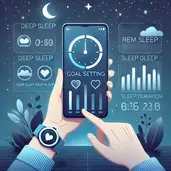
Goal Setting
The Sleep Experiment
Primary and Secondary Outcomes
Each experiment in the Lifestyle Experiment (Sugar, Fitness, Sleep, and Food) includes primary and secondary outcomes to measure changes over time.

Primary outcomes are usually short-term, responsive metrics that are the most likely to change as a result of the intervention. Good choices for the sleep experiment include:
✅ Sleep Score (various devices)
-
Total Sleep
-
Timing of Sleep
-
Restlessness Measures
-
Amount of Deep Sleep
-
Amount of REM Sleep
✅ Epworth Sleepiness Scale
✅ Subjective Motivation Scale

Secondary outcomes are usually long-term health indicators that may or may not change within the proposed timeframe but if they do, its a bonus. Good secondary outcome choices for the sleep experiment include:
✅ HbA1c
✅ Fasting Insulin
✅ Fasting Glucose
✅ Triglycerides
✅ hsCRP

The Sleep Experiment: Hypothesis Statement
Like the Fitness and Strength experiment, the Sleep Experiment requires a compound hypothesis statement. Essentially, two separate experiments are happening simultaneously: Improving sleep quality and duration. Measuring how those sleep improvements impact metabolism and body composition. To start, you will evaluate your current state after completing the Sugar and Fitness/Strength experiments. A sample starting statement is: After completion of the sugar and fitness/strength experiments, my body fat percentage is now down to 22% (man), 32% (woman), my HbA1c is down to 5.7, and my hsCRP has decreased from 2.0 to 1.7. I feel much better, but I am concerned that maintaining my discipline with exercise and avoiding carbohydrates may become more difficult over time. I have screened negative for sleep apnea, anxiety, depression, and substance use. (If this is NOT the case for you, consult a physician before proceeding.) The Sleep Experiment is the first stage where long-term sustainability becomes a major focus. Research shows that poor sleep increases emotional vulnerability, making it harder to maintain discipline with exercise, nutrition, and lifestyle changes. Because of this, a key part of your hypothesis should be how improving sleep will help you sustain your overall lifestyle experiment. Sample Hypothesis 1: Sleep Improvement Knowing that my typical nightly sleep score is 64—driven largely by restlessness and poor deep sleep—and my daily Epworth score is 14, I can improve my nightly sleep score to 70 or more and reduce my daily Epworth score to less than 10 by implementing the seven CALTATA interventions over two months. Sample Hypothesis 2: Metabolic Improvement An improvement of six points in my nightly sleep score and a reduction in my Epworth Sleepiness Score to less than 10 will enhance my ability to sustain my fitness and nutrition program, leading to further improvements in my metabolic markers. Specifically, I expect my HbA1c to decrease to 5.6 and my body fat percentage to drop to 21% (man), 31% (woman).






